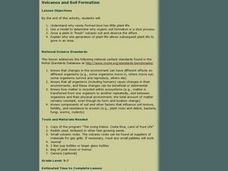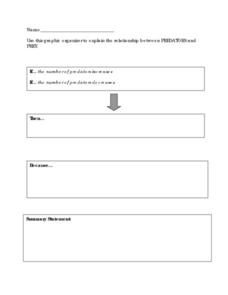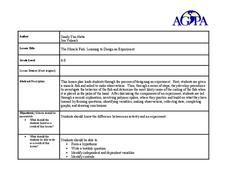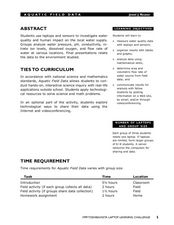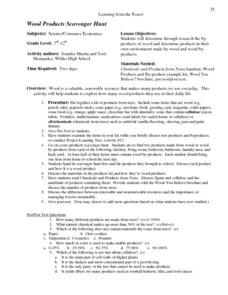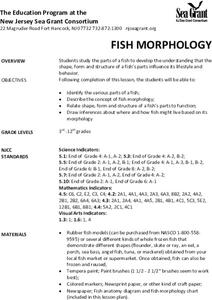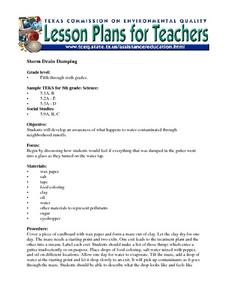Curated OER
Why So Many Frogs?
Students explain the different stages in the growth of a frog, then analyze and collect data to make generalizations about a larger population. They determine the survival rate of a population of tadpoles under controlled conditions.
Curated OER
Earthquake!
Students gain an understanding of earthquakes. They examine vocabulary associated with earthquakes, how earthquakes happen, and preventive measures taken to diminish damage or harm in the event that an earthquake should happen.
Curated OER
Predators and Prey
Students explain how the food chain works. They contrast predators with prey and describe their function in nature. Students discuss how the food chain aids in keeping nature balanced. In small groups, they play a game that simulates the...
Curated OER
The Hall of Physicist
Students study the history and scientific contributions of Albert Einstein. In this Albert Einstein lesson plan, students learn his history, research his scientific contributions, create a timeline of him and his work, and create a...
Curated OER
Elements
In this elements worksheet, students determine the atomic number, mass, number, electrons, protons, and neutrons for elements. Students review the electromagnetic spectrum. This worksheet has 1 graphic organizer and 13 multiple choice...
Curated OER
The Miracle Fish: Learning to Design an Experiment
Students develop procedures to explore the behavior of fish. In this scientific experiment lesson students from a hypothesis, write a question, identify different variables and controls in their experiment.
Curated OER
Aquatic Field Data
Students use laptops and sensors to measure water quality and graph their results. In this aquatics activity students post their results to a website or email.
Curated OER
Animals Vocabulary Maze
In this animal vocabulary worksheet, students read the clue and answer it with an animal vocabulary word and then find the word in the maze. Students complete 14 questions.
Curated OER
Animals-Spelling Activity
In this animals spelling worksheet, students are given definitions related to animals and their habitat, then fill in missing letters in words to complete the matching animal spelling word.
Curated OER
Wood Products Scavenger Hunt
Students investigate the by-products of wood and explore the wood products in their own environment. Products containing both cellulose and silvichemicals obtained from the trees are examined in this lesson plan.
Curated OER
Ecology: Factors Influencing Animal Populations
Learners assess the factors affecting animal populations. Working in groups they define specific vocabulary terms and complete several activities from "Project Wild."
Curated OER
Environmental Conditions: Friend or Foe
Students research and answer questions on how organisms are classified and how their needs are met through their environment. They work in small groups and create a poster, chart, rap, PowerPoint, or brochure demonstrating how organisms...
Curated OER
The Circulatory System
Students explore the circulatory system of animals. Using the Internet, students research animals without circulatory systems. They identify the three types of blood vessels and describe the flow of blood through the heart. Finally,...
Curated OER
the Naturalist's Notebook
Third graders, after brainstorming what they already know about trees and what effect the seasons have on them, create a model of a hollow log. They participate in a young naturalist's notebook writing activity while walking outside...
Curated OER
Arctic cleanup
Ninth graders examine pollution problems and how it affects the community. In this arctic cleanup lesson students study ocean currents and how they affect pollution.
Curated OER
Fish Morphology
Learners identify the various parts of a fish. They describe the concept of fish morphology and relate shape, form and structure of a fish's parts to function.
Curated OER
Food Chains Are Not A Necklace!
Second graders examine how food chains interact with different plants and animals. They practice using new vocabulary. They also discover the role of pesticides in the environment.
Curated OER
Storm Drain Dumping
Students conduct an experiment to show how water gets contaminated through neighborhood runoffs.
Curated OER
Clay Hill Animal Sampling
Students create animal print casts from molds in the classroom. They use the cast patterns to identify animal prints on a field trip in which they locate animal tracks, identify the location with GPS and create field casts of the...
Curated OER
Animal and People Habitats
Students examine how animals create a unique space in which they can live. Students read a poem about animals' habitats discuss the habitats. They draw a space of their own and write a poem that describes their habitat.
Curated OER
Making Something from Nothing
Learners explore how to make something out of nothing. In this recycling lesson plan, students discuss the importance of recycling and what effects their choices could have on future generations. Learners create something new out of...
Curated OER
Ecology and the Conservation of Natural Resources Lesson 2
Students compare and contrast abiotic and biotic factors. They discuss how these factors effect ecosystems. They answer questions to complete the lesson.
Curated OER
Waste Minimization and Protecting the Environment
Pupils study the amount of waste produced and its effects on the environment. They discuss food, money, and energy and how their waste effects others. They read a play to explore how waste is produced and create a collage of materials...
Curated OER
THE FOODS WE EAT
Students discuss the five food groups and the seven basic nutrients. They decorate Food We Eat booklet pages with pictures of foods found on background, rubber stamp and animation tools in KidPix. (Booklet has a page for each food group.)
